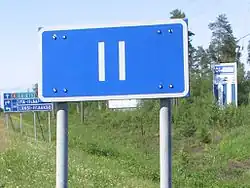Ii, Finland
Ii (Finnish pronunciation: [iː]; Swedish: Ijo) is a municipality of Finland. It is situated by the Bothnian Bay, at the mouth of river Iijoki, and it is part of the Northern Ostrobothnia region. The municipality has a population of 9,796 (19 September 2023)[2] and covers an area of 2,872.44 km2 (1,109.06 sq mi) of which 1,256.69 km2 (485.21 sq mi) is water.[1] The population density is 6.31/km2 (16.3/sq mi).
Ii
Ijo | |
|---|---|
Municipality | |
| Iin kunta Ijo kommun | |
 | |
 Coat of arms | |
 Location of Ii in Finland | |
| Coordinates: 65°19′N 025°22′E | |
| Country | |
| Region | North Ostrobothnia |
| Sub-region | Oulunkaari |
| Charter | 1445 |
| Government | |
| • Municipal manager | Ari Alatossava |
| Area (2018-01-01)[1] | |
| • Total | 2,872.44 km2 (1,109.06 sq mi) |
| • Land | 1,552.54 km2 (599.44 sq mi) |
| • Water | 1,256.69 km2 (485.21 sq mi) |
| • Rank | 42nd largest in Finland |
| Population (2023-09-19)[2] | |
| • Total | 9,796 |
| • Rank | 98th largest in Finland |
| • Density | 6.31/km2 (16.3/sq mi) |
| Population by native language | |
| • Finnish | 99% (official) |
| • Swedish | 0.2% |
| • Others | 0.8% |
| Population by age | |
| • 0 to 14 | 22.5% |
| • 15 to 64 | 56.2% |
| • 65 or older | 21.3% |
| Time zone | UTC+02:00 (EET) |
| • Summer (DST) | UTC+03:00 (EEST) |
| Website | www |
The municipality is unilingually Finnish.
Ii merged with Kuivaniemi on 1 January 2007. The new municipality retained the name Ii, but adopted the coat of arms of Kuivaniemi. Ii is notable for having the shortest place name in Finland, and also one of the shortest ones in the world. The etymology is not definitively established; options are either Germanic origin or Sami origin. In the latter, it would mean "a place to stay overnight in"; cf. Northern Sami idja "night".[5]
Beginning in 2008, Ii is home to the ART Ii Biennale of Northern Environmental and Sculpture Art, an international art fair.
The city has ambition to become the first zero waste town in the world, and its municipal manager claims that it does not use fossil fuels for energy.[6]
History
Ii is named after the river Iijoki. The original name of the settlement was Iijoen kylä, first mentioned in 1374 as Yioki when it was a chapel community within the Pedersöre parish. The marketplace Iin Hamina has existed since the 14th century. Ii became a separate parish sometime before 1445.
The parish of Ii was originally larger than the modern municipality: it included Pudasjärvi and Taivalkoski until 1639, Kiiminki, Ylikiiminki and Haukipudas until 1858. The municipality of Kuivaniemi was split off in 1919 and Yli-Ii was split off in 1924.[7]
Kuivaniemi became a part of Ii again in 2007. When Yli-Ii was merged into Oulu, a part of it was given to Ii as an exclave. This exclave contains the Pahkakoski hydroelectric power plant.

The village of Jakkukylä and its surroundings, originally part of Yli-Ii and a part of Oulu from 2013, decided to join Ii in 2018.[8]
Notable people
- Juhamatti Aaltonen, ice hockey player
- Pekka Ahmavaara, politician and father of Arvi Ahmavaara, another politician
- Liisa Hyssälä, politician
- Hannu Järvenpää, ice hockey player and coach
- Tanja Kari, Paralympic gold medalist in cross-country skiing
- Sanna Koivisto, sculptor
References
- "Area of Finnish Municipalities 1.1.2018" (PDF). National Land Survey of Finland. Retrieved 30 January 2018.
- "Finland's preliminary population figure was 5,587,841 at the end of August 2023". StatFin. Statistics Finland. Retrieved 30 September 2023.
- "Demographic Structure by area as of 31 December 2022". Statistics Finland's PX-Web databases. Statistics Finland. Retrieved 6 September 2023.
- "Population according to age (1-year) and sex by area and the regional division of each statistical reference year, 2003–2020". StatFin. Statistics Finland. Retrieved 2 May 2021.
- Hyyryläinen, Toivo: Kahden kirjaimen pitäjä, Iin perinnekirja. Saarijärven Offset, 2006.
- "New generation of climate heroes". BBC News. Retrieved 22 June 2019.
- "SuomalainenPaikannimikirja_e-kirja_kuvallinen.pdf" (PDF). kaino.kotus.fi (in Finnish). p. 96. Retrieved 18 August 2022.
- "Tietoa meistä :: Jakkukylä". jakkukyla.fi (in Finnish). Retrieved 12 October 2022.
External links
 Ii travel guide from Wikivoyage
Ii travel guide from Wikivoyage Media related to Ii at Wikimedia Commons
Media related to Ii at Wikimedia Commons- Municipality of Ii – Official website
